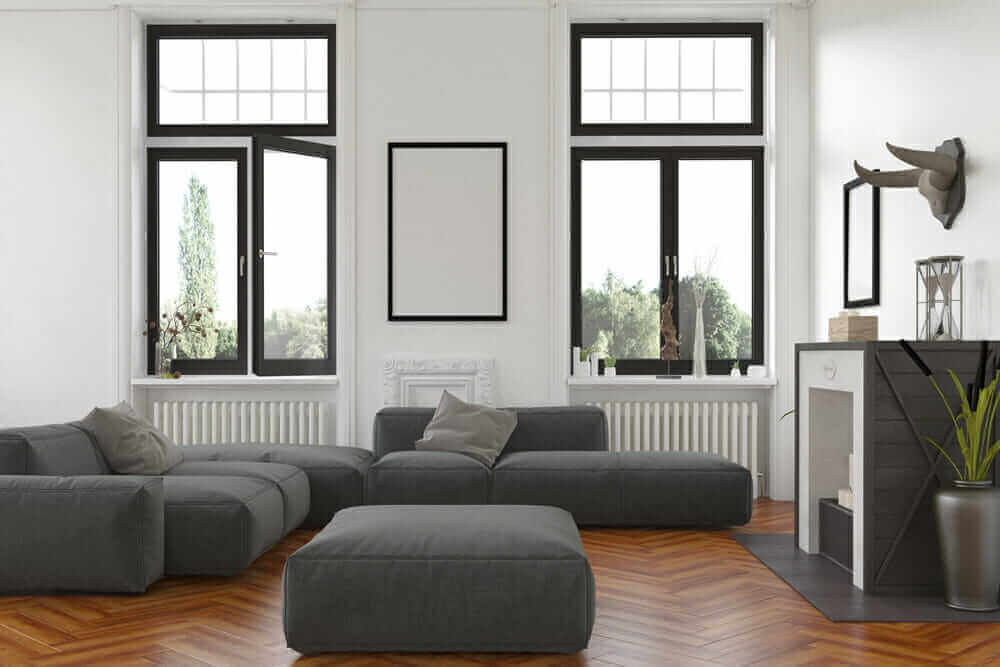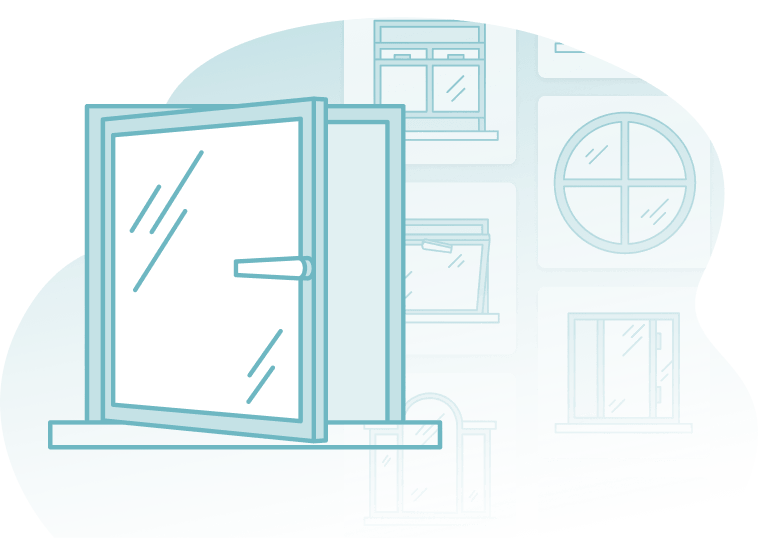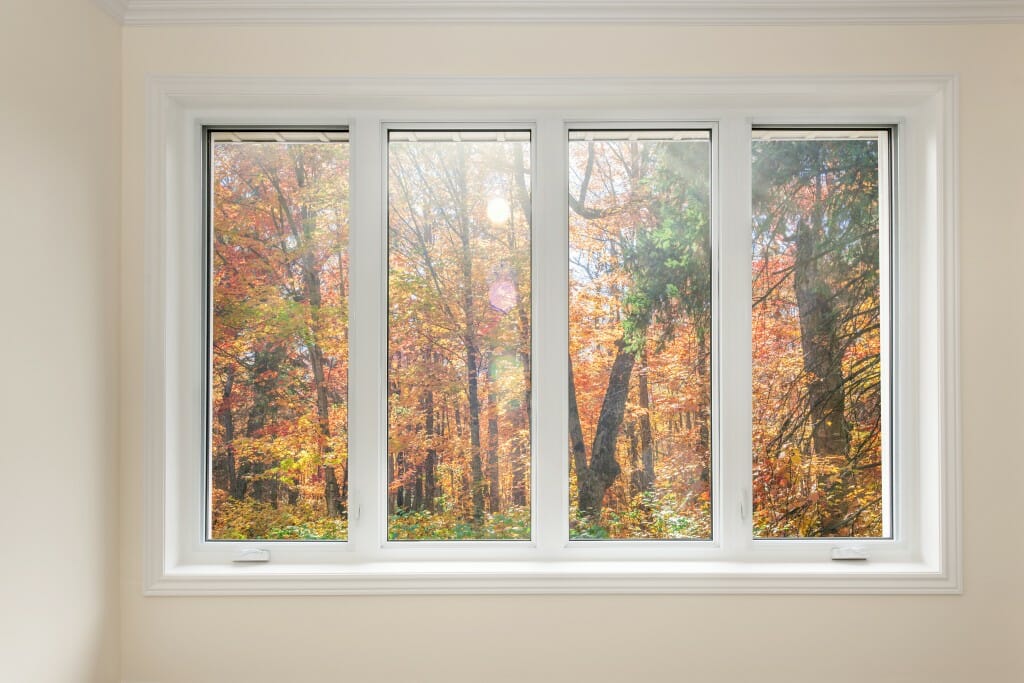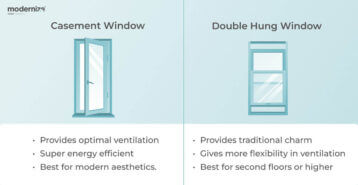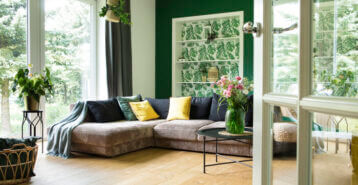Casement windows are a great choice for homeowners looking to do a replacement window project due to their relatively low cost, ease of use, and ventilation capabilities. On this page, learn all about casement windows and decide if they are the best choice for your home.
What is a Casement Window?
What sets casement windows apart from other window types is how they operate. Casement windows, commonly identified as a “window with a crank,” open outward from the left or ride side by cranking a handle. They can be installed alone or as a multiple-lite configuration.
When and Where Should I Use Casement Windows?
For a distinctive look, some homeowners place a casement window on either side of a picture window, single-hung, or double-hung window, or as part of a bay or bow window configuration.
Homeowners also commonly install casement windows in areas of the home where they want or need more ventilation. For example, casement windows are a great choice for in the kitchen over a sink or in a bathroom to let in more air and light.
Additionally, casement windows offer great weatherproofing, since they seal efficiently, and security, since they lock when closed. Both these features mean they make an excellent choice for windows throughout the home.
Parts of Casement Windows
Casement windows have specific characteristics that make them easy to recognize. Parts of a casement window include:
- the frame.
- crank.
- locking mechanism.
- hinge.
Optional features include a mullion if there are two side-by-side casement windows and a decorative grill pattern.
Casement windows can come with or without screens. If you do want to add screens, be aware they are installed from the inside so as not to interfere with window opening and closing.
How Do Casement Windows Operate?
Just like a front door, windows that crank out open to the outside. Casement windows typically have side-mounted hinges that allow it to open from the right or left side, though some are available with top hinges instead.
Casement windows are often described as “windows with hand cranks,” and for good reason! That is one of their most distinguishing features. However, you can also choose casement windows that push open outwards instead, no crank required.
Casement Window Types
A benefit of casement windows is their versatility and ability to be customized. Different materials, configurations, and options allow you to create a look that is unique and tailored to your style preferences. However, there are also many popular styles that come standard. Here are the most popular casement window types.
- Single casement window. This consists of a single sash that opens outward on one side, usually hinged on the left or right.
- French casement window. Also called a double casement window, this type consists of two casement windows side by side, each hinged on opposite sides.
- Push-out casement window. Instead of a crank or lever, push-out casement windows are operated by pushing the window open manually.
- Top-hung casement window. In this variation, the window is hinged at the top and opens outward from the bottom.
There are seven main types of casement windows to choose from, each best for different rooms or aesthetic styles.
Casement Window Material
Like most other window types, casement windows are available with several different framing materials. Each material has its own set of advantages and disadvantages, from durability, price, aesthetics, and energy efficiency:
- Vinyl casement windows
- Aluminum casement windows:
- Wood casement windows
- Fiberglass casement windows
Casement Window Types by Operation
In addition to frame material, you also have the choice of operation when selecting your casement windows.
- A crank-style opening is the most traditional casement window type.
- A push-out casement window includes a locking mechanism only — to open the window, simply push on the unhinged side.
- Casement windows are also available to open toward the inside of the home. Called in-swing or pull-in windows, they work well for upper floors and for areas with heavy shrubs close to a home’s exterior.
Size Options for Casement Windows
A general rule of thumb: the larger the window, the more expensive your final project cost. You’ll want to choose a size that suits your style as well as any special requirements for the room the window is going in. For example, if it is going in a bedroom, does it need to meet egress requirements?
Casement window sizes start at about two feet by four feet and then go up in two inch increments. Research all your casement window size options so you know what comes standard and what might need to be custom made.
Pros and Cons of Casement Windows
There are a several advantages and a couple of disadvantages to choosing casement windows. Let’s take a quick a look at the pros and cons of casement windows in this table, and then we will break each down in more detail below.
-
Pros
- Excellent air flow
- Very energy efficient and safe
- Versatile design options
- Unparalleled views
-
Cons
- Can be difficult to adjust
- Young children will be able to open them
- Require more space for window to open
Pros
Ventilation
If you live in a warmer climate, casement windows can provide much-needed airflow and add to your comfort. Their side opening allows them to catch breezes and direct them inside the home, which makes them a good option for upstairs rooms, bathrooms, and kitchens.
Energy Efficiency
Casement windows are more energy efficient than single or double hung windows. They do not require a track to operate and provide a more airtight seal when closed. Choose double or triple-paned casement windows to improve energy efficiency.
Design Versatility
One of the characteristics of casement windows that makes them popular is they go well with nearly any traditional or modern architectural style. They are often combined with other window types to create distinction and charm. For example, two casement windows may flank a large picture window or may be added to a bow or bay window configuration. Adding grill patterns can even further customize their look to your home’s exterior.
Unobstructed Views
A casement window is a great option if you want to take advantage of property views. It acts as a picture window but includes the ability to open and close.
Security
Casement windows offer more home protection than standard single or double hung windows due to their operation. They can only be opened from the inside and would require breaking glass to gain home entry, a deterrent against intruders.
Cons
Difficult to Adjust
While casement windows are great for letting in cool air when you need it, they are limited when it comes to adjustability. They open up and close easily, but there aren’t many angle options for the window to stay open on its own.
Many people add casement window stays to their casement windows. While some windows come with built-in stays, or cranks to help you adjust the position, others simply open and close without anything but a stop to keep them from opening too far.
May Not Be Best for Homes With Young Children
Casement windows are very easy to operate. So easy, in fact, that young kids will be able to open and close them without assistance. Since many homeowners choose casement windows for the views they provide, they do not always install screens (though screens can be installed from the inside). Once the screenless window is open, it would be fairly simple to get out of it. If you are considering this window type, you should also consider how easily young children will be able to access and operate a casement window.
Needs More Space Than Other Window Types
Whether you choose casement windows that open in or out, you will need to make sure there is space for the window to crank or push open fully. With an in-swing casement window, this means ensuring there is no furniture or breakable items the window may be impeded by. With an out-swing window, this means you cannot have shrubbery, trees, or a walking path too close to your home.
Are Replacement Casement Windows the Best Choice for Your Home?
Here are four factors to consider if you’re trying to decide if casement windows are right for you.
1. Ventilation
A casement window is a good choice if you are looking to improve a room’s airflow and comfort. Rooms located on upper floors tend to get warmer in the spring and summer and may require more windows that provide additional cooling and good ventilation.
Casement windows are also an option for kitchens and bathrooms, as they help dissipate heat, humidity, and odors.
2. Climate
Some climates are more suitable for casement windows than others. For example, homes in regions that experience arid and hot spring and summers would benefit from the additional ventilation and airflow casement windows provide.
3. Maintenance
Cleaning and maintenance are necessary to keep your windows looking and functioning optimally. Casement windows are relatively easy to clean due to their side operation. If installing casement windows on upper floors, consider an in-swing style that opens inward for safer cleaning.
4. Lifespan
A casement window’s lifespan is determined by manufacturer quality and how well it is maintained. A good quality casement window installed correctly can last 20 years or longer. A quality installation will allow you to maximize a casement window’s lifespan, so choosing an experienced window installer is essential.
Finding Casement Window Installers
To maximize the lifespan of your casement windows and maintain your manufacturer’s warranty, a quality installation is essential. Let Modernize do the legwork for you — use our window cost calculator for a budgetary estimate or get connected with local professional window installers for a custom quote by clicking below.
Compare top-rated windows pros in your area.
Read real homeowner reviews, explore qualifications, and view promotions. Modernize makes it easy to browse professionals and find one that will be perfect for your project.
